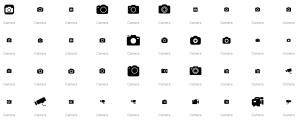In the ever-evolving realm of graphic design, certain icons stand as timeless symbols of innovation, functionality, and aesthetic appeal. Among these icons, cameras hold a unique place, representing not only the art of capturing moments but also embodying the evolution of technology and the visual language of communication. From the rudimentary beginnings of the camera obscura to the sleek digital marvels of today, the journey of cameras intersects with the evolution of graphic design in fascinating ways. In this exploration, we delve into the visual evolution of camera icons and their profound impact on graphic design.
Capturing the Past: Camera Obscura and Early Photography

The story of camera icons begins centuries ago with the invention of the camera obscura, a precursor to modern cameras. This simple optical device projected an image onto a surface, allowing artists to trace the scene before them. As photography emerged in the 19th century, cameras evolved from cumbersome contraptions to more portable devices. The iconic boxy shape of early cameras, such as the daguerreotype and the Kodak Brownie, became synonymous with the art of photography itself. In graphic design, these early camera icons adorned advertisements, posters, and packaging, symbolizing the power of visual imagery to capture moments in time.
The Rise of Modernism: Bauhaus and the Leica Revolution
The early 20th century saw a shift towards modernism in both art and design, with the Bauhaus school leading the way in embracing simplicity, functionality, and geometric forms. This ethos extended to the design of cameras, most notably with the introduction of the Leica I in 1925. The Leica revolutionized photography with its compact, streamlined design and precision engineering, embodying the principles of modernist design. Its iconic silhouette, characterized by clean lines and minimal detailing, became a symbol of avant-garde creativity and technical innovation. In graphic design, the Leica camera icon served as a visual shorthand for modernity and progress, appearing in advertisements and promotional materials for a wide range of products and services.
Pop Culture and Iconic Cameras
As the 20th century progressed, cameras became not only tools of documentation but also symbols of cultural identity and personal expression. Iconic camera models such as the Polaroid SX-70 and the Nikon F became synonymous with moments of joy, adventure, and self-discovery. The Polaroid instant camera, with its ability to produce immediate tangible photographs, captured the imagination of millions and became a cultural phenomenon. Its distinctive folding design and rainbow stripe motif adorned everything from album covers to fashion accessories, leaving an indelible mark on the visual landscape of the era. Similarly, the rugged durability and precision engineering of the Nikon F made it the camera of choice for professional photographers and photojournalists, its unmistakable form becoming a symbol of journalistic integrity and creative excellence.
Digital Revolution: From Film to Pixels
![]()
The turn of the 21st century brought about a seismic shift in the world of photography with the advent of digital technology. Cameras evolved from mechanical devices that exposed light onto film to sophisticated electronic devices that captured images as digital data. The iconic physical forms of traditional cameras gave way to sleek, compact designs that housed complex digital sensors and processors. The rise of digital cameras, from point-and-shoot models to professional DSLRs, democratized photography and transformed the way we capture and share images. In graphic design, the transition from analog to digital photography opened up new creative possibilities, enabling designers to manipulate and enhance images with unprecedented ease. The camera icon, once a symbol of mechanical precision, now represented the limitless potential of digital imaging technology.
Conclusion: A Continuing Legacy
In conclusion, the visual journey of camera icons in graphic design reflects not only the evolution of technology but also the changing cultural and aesthetic sensibilities of the times. From the humble beginnings of the camera obscura to the digital marvels of today, cameras have remained constant companions on our visual journey through history. As symbols of innovation, creativity, and human connection, camera icons continue to inspire and captivate us, reminding us of the power of imagery to shape our perceptions and memories. In the ever-expanding universe of graphic design, the iconic silhouette of the camera remains a timeless symbol of our enduring fascination with the art of seeing and capturing the world around us.
